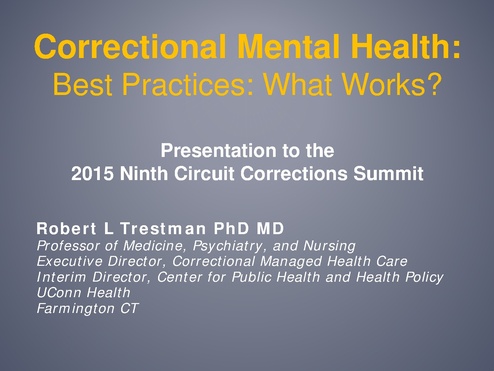Correctional Mental Health Best Practices, 9th Cir Corrections Summit, 2015
Download original document:

Document text

Document text
This text is machine-read, and may contain errors. Check the original document to verify accuracy.
Correctional Mental Health: Best Practices: What Works? Presentation to the 2015 Ninth Circuit Corrections Summit Robert L Trestman PhD MD Professor of Medicine, Psychiatry, and Nursing Executive Director, Correctional Managed Health Care Interim Director, Center for Public Health and Health Policy UConn Health Farmington CT AGENDA 1) Best practice and guidelines 2) Implementation science 3) Suicide risk reduction 4) Psychotherapy 5) Pharmacology 6) Community Transitions 7) Academic partnerships 1: Principles Governing the Delivery of Psychiatric Services 2: Guidelines for Psychiatric Services 3: Special Applications of the Principles and Guidelines • Community Standard: “what the community should be providing. . .” • Staffing- adequate to provide services • Culture – Therapeutic vs retributive IMPLEMENTATION SCIENCE Exploration Preparation Adm Policy Ment Health (2011) 38:4–23 7 Implementation Sustainment 1) IMPLEMENTATION SCIENCE IN CORRECTIONAL MENTAL HEALTH OUTER CONTEXT Sociopolitical Leadership Policies initiatives, settlements, decrees Funding Public-academic collaboration 1) IMPLEMENTATION SCIENCE IN CORRECTIONAL MENTAL HEALTH INNER CONTEXT Organizational characteristics Leadership Embedded EBP culture Critical mass of EBP provision Social network support Fidelity monitoring/ support EBP role clarity Fidelity support system Supportive coaching Staffing Staff selection criteria Validated selection procedures SUICIDE RISK REDUCTION • Culture • Screening- admission and at times of high stress • Assessment • Treatment • Physical plant issues • Non-punitive suicidal ideation management • Supervision / Quality Assurance • High Risk : Restricted Housing Environments PSYCHOTHERAPY • Cognitive Behavioral Therapies • Manual-Guided, Clinician Driven • Evidence of Benefit: – Moral Reconation Therapy – Reasoning and Rehabilitation – STEPPS – START NOW • Developed for offenders with behavioral disorders • NIJ funded development • Public domain materials Connecticut Maine New Jersey New York (training begins March 2016) Kersten, Linda, et al. Psychiatric Services (2015): appi-ps. PHARMACOLOGY • Current community medications may have been determined while ongoing illicit drug use confounded diagnosis • Collaboration between clinician and patient may have been poor; treatment adherence may in turn have been marginal. • Patients with schizophrenia: 29% non-adherent, with substance abuse a significant risk factor Baillargeon, J. et al. (2010). Admin & Policy in Mental Health and Mental Health Services Research, 37(4):367-374. Novick, D., et al. (2010). Psychiatry Research, 176(2):109-113. Mojtabai R, Olfson M. (2010). Archives of General Psychiatry. 67(1):26-36. • Advantage of correctional psychiatry: opportunity to observe the functioning of a patient in a safe, monitored environment • When diagnostic ambiguity exists, appropriate tapering off of community medications can be conducted with greater safety and collateral information than achievable elsewhere. • Very little evidence that several drugs are ever better than one Trestman R. Transition of pharmacology from community to corrections. In Trestman RL, Appelbaum KL, Metzner JL (Eds), Oxford Textbook of Correctional Psychiatry, Chapter 19, 2015. Tiihonen, J., et al. (2012). Archives of General Psychiatry, 69(5):476-483 These drugs may be abused for their sedative properties, mind altering effects, or for the potential to get a high – pulverized & snorted or IV RISK: ABUSE OF PRESCRIBED • bupropion (Wellbutrin) MEDICATION • gabapentin (Neurontin) • quetiapine (Seroquel): – “quell”, “Susie Q” , “Q-ball”, or “baby heroin” • • • • • Reccoppa L , Malcolm R , Ware M. Gabapentin abuse in inmates with prior history of cocaine dependence. Am J Addict. 2004;13(3):321–3. Pierre JM , Shnayder I , Wirshing DA , Wirshing WC. Am J Psychiatry. 2004;161(9):1718. Waters BM , Joshi KG. Am J Psychiatry. 2007;164(1):173–4. Pinta ER , Taylor RE. Quetiapine addiction?. Am J Psychiatry. 2007;164(1):174–5. Hanley MJ , Kenna GA. Am J Health Syst Pharm. 2008;65(7):611–8. COMMUNITY CONTINUITY • Education and engagement • Reduce pill burden: Once daily dosing when possible • Transition back to the community – Medicaid continuity/ enrollment – Clinical connection: in-reach and out-reach Kesten KL, et al. Journal of Correctional Health Care, 2012, 18(1):20-8. Trestman RL, Aseltine RH. Perspectives in Health Information Management. 2014 Winter; 11(Winter): 1e. Mortality Rates among Former Inmates of the Washington State Department of Corrections during the Study Follow-up (Overall) and According to 2-Week Periods after Release from Prison. BINSWANGER IA ET AL. N ENGL J MED 2007;356:157-165. ACADEMIC PARTNERSHIPS • Research and evaluation • Training and recruitment • Enhanced employee engagement and morale

